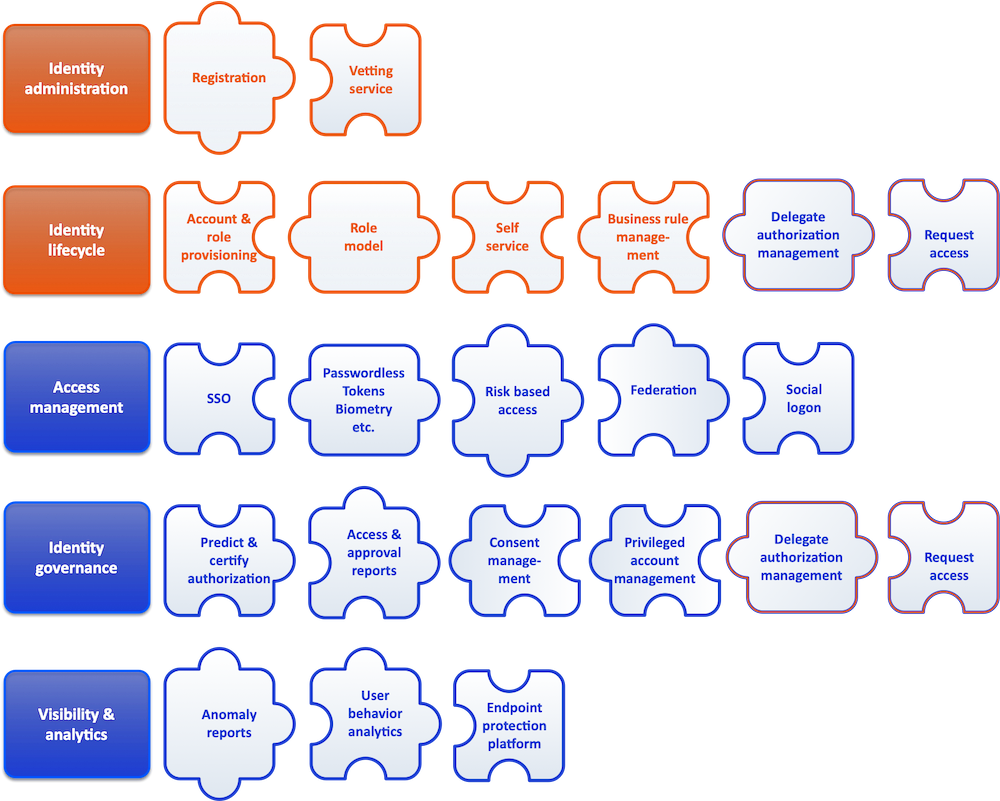As we state in our vision on security, a good zero trust infrastructure stands or falls with security at the top of the zero trust stack: the identities. One trend in the market is to break down information services into small components, each of which can be deployed separately, called “microservices. Managing your identities can also be approached this way.
Modular IAM (Modiam).
Capitar uses the following overview, with the microservices for IAM as puzzle pieces, which we call ‘identity modules’:

A characteristic of a microservice is that it covers a separate business need and can be set up and run independently. While this sounds nice in theory, in practice there are always interdependencies and some microservices are required for another microservice to work properly.
Anomaly reports, for example, are useless if there is no basic identity registration. This is why we have divided the microservices into five groups, each of which forms a logical whole.
Five groups
The top two form the basis for IAM, namely the identity modules needed to capture identities, identity administration, and the identity modules needed to manage the lifecycle of a captured identity, identity management. On a solid IAM foundation, depending on the needs of the organization, the IAM function can be built out with one or more microservices from the underlying three groups of advanced identity modules: Access management includes all the identity modules needed to simplify and monitor the various forms of access to your information. Identity governance are the modules that help to gain insight and overview over the issued rights and enables the organization to assign the right responsibilities to the right places. Visibility & analytics provides information about the current behavior of identities and thus ensures that the right measures are taken at the right time.
Identity modules
An identity module is more than a piece of technology. It is an interplay of policy, organization, processes and supporting tools. Depending on the module and your question, attention will be divided differently over these aspects when setting up, improving and implementing a module. Capitar Security helps you determine which of the identity modules offer the most added value for you and which steps need to be taken to deploy the most valuable modules quickly and effectively.
How to solve the puzzle?
No organization is capable of solving this puzzle all at once, and no organization has the need to deal with all the pieces of the puzzle at once. In our view, the following approach leads to the most successful outcome:
- Do a thorough risk analysis in all access and identity areas.
- There is no “greenfield,” so map out what puzzle pieces already exist.
- Identify which puzzle pieces are inadequate or missing.
- Prioritize together with the business the order of approach.
And then puzzle piece by puzzle piece:
- Establish the organization’s needs and requirements.
- Determine what adjustment to organization and technology are needed.
- Implement the improvements.
Modiam is more!
Modiam is not only a model for IAM, but also stands for our implementation methodology. We use a normalized data model and prefabricated application interfaces that make the technical implementation very fast. This also applies to changes.
Because we use this method with every customer, supporting or managing our IAM implementations can be done by any of our IAM specialists and you will always be helped quickly.
Vendors
We use the software of several market leaders for IAM as the basis for our services: Micro Focus and SailPoint. We are happy to help you make the right choices.
©Steven van der Linden, June 2020


